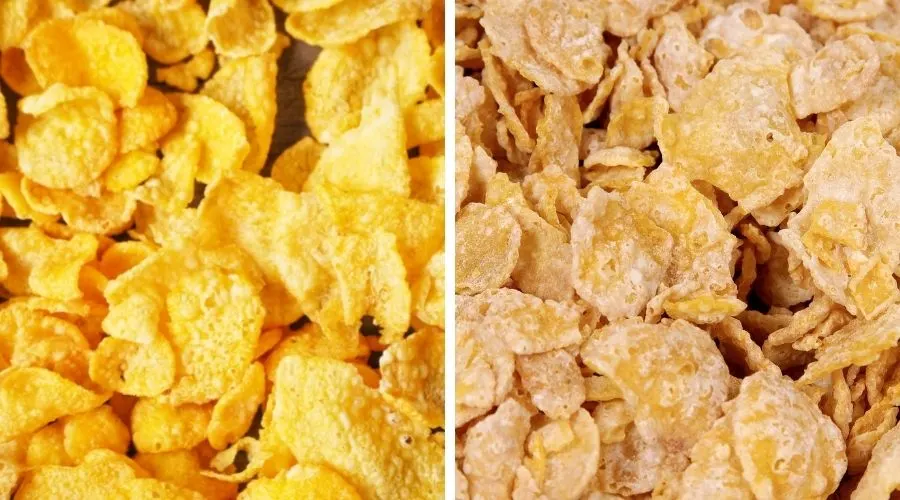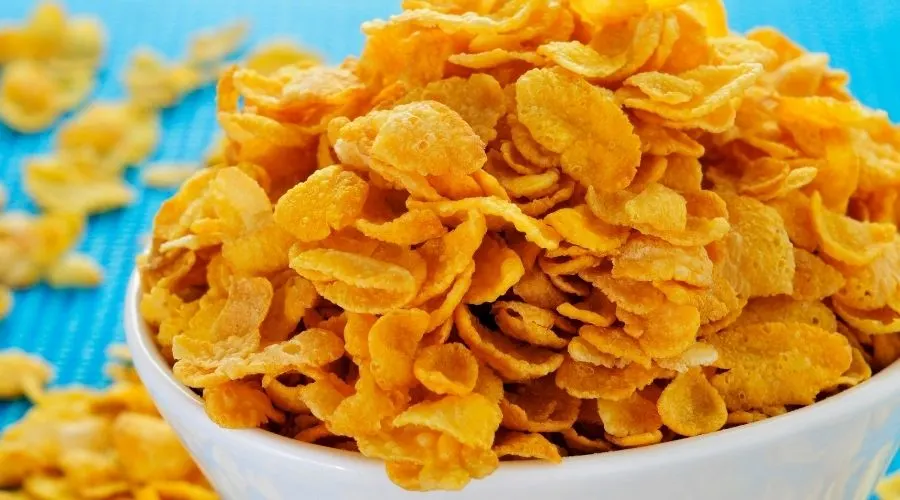They look very similar, they’ve got a similar texture, and they’re both family favorites which we’ve grown up with over the years, but what’s the difference between the two?
Corn Flakes are thought to be the healthier and plainer option than Frosted Flakes, which look like they’re coated in sugar, but this might not be the case.
In this article, I’ll be comparing Kellogg’s Corn Flakes against Frosted Flakes to find out the difference between the two and which is best for nutrition and price.
Read on to find out who’s the winner in the Corn Flakes Vs. Frosted Flakes Contest and take part in our poll to tell us which is your favorite.
Also in This Article
In a hurry, or looking for something specific? Use the links below to jump to the relevant section:
Corn Flakes V’s Frosted Flakes Nutritional Comparison:
Best for Carbs & Sugar Content
The information in this article relates to USA brand cereals, if you need the UK comparison, click the link to go to the article below:
Ingredients Comparision
Starting with the ingredients comparison, you might be surprised to know that Corn Flakes and Frosted Flakes contain exactly the same ingredients, although we don’t know at this stage how much. For example, both kinds of cereal contain sugar, but does one have more than the other?
Corn Flakes and Frosted Flakes are both corn-based cereals that are made from milled corn as the main ingredient.
Both kinds of cereal are also fortified with the same added vitamins and minerals, although the amounts may differ (which I’ll compare later in this article).
| Cereal Type | Ingredients | Vitamins and Minerals |
| Kellogg’s Corn Flakes | Milled corn, sugar, malt flavor, contains 2% or less of salt. | Iron (ferric phosphate), niacinamide, vitamin b6 (pyridoxine hydrochloride), vitamin b2 (riboflavin), vitamin b1 (thiamin hydrochloride), folic acid, vitamin d3. Vitamin b12. |
| Kellogg’s Frosted Flakes | Milled corn, sugar, malt flavor, contains 2% or less of salt. | Iron (ferric phosphate), niacinamide, vitamin b6 (pyridoxine hydrochloride), vitamin b2 (riboflavin), vitamin b1 (thiamin hydrochloride), folic acid, vitamin d3, vitamin b12. |

Corn Flakes Vs. Frosted Flakes Nutritional Comparison
Moving onto the nutritional comparison and to ensure the data is accurate and fair, we need to compare the cereals on a weight-for-weight basis.
A recommended serving of Corn Flakes is 42g, whereas the recommended serving of Frosted Flakes is 37g, which means the servings aren’t equal. So, I’ve calculated nutrition based on a weight of 100g per cereal and also included the serving values for information.
The comparisons are based on Kellogg’s Brand Corn Flakes and Frosted Flakes, and you can see the data references at the bottom of this page.
Best for Calorie Content
When comparing the calorie content of Corn Flakes and Frosted Flakes, weight-for-weight Frosted Flakes contain slightly fewer calories per 100g.
A serving of Frosted Flakes contains 20kcal fewer calories, which is also because a serving weighs 5g less than a serving of Corn Flakes.
| Cereal Type | Calories Per 100g | Calories Per Serving |
| Kellogg’s Corn Flakes | 357kcal | 150kcal (Per 42g Serving) |
| Kellogg’s Frosted Flakes | 351kcal | 130kcal (Per 37g Serving) |
Best for Carbohydrate Content
Both Corn Flakes and Frosted Flakes are high in carbohydrates compared to some other lower-carb breakfast choices, but if this is something you’re looking to track, Corn Flakes are slightly lower in carbs per weight of cereal.
| Cereal Type | Carbohydrates Per 100g | Carbohydrates Per Serving |
| Kellogg’s Corn Flakes | 85.7g | 36g (Per 42g Serving) |
| Kellogg’s Frosted Flakes | 89.2g | 33g (Per 37g Serving) |
Best for Sugar Content
When it comes to sugar content, this is where Corn Flakes and Frosted Flakes differ the most because Frosted Flakes contain over three times the amount of sugar per weight compared to Corn Flakes.
To put this in perspective of how much sugar they contain, Frosted Flakes have 24% of your recommended daily sugar intake compared to Corn Flakes, which contain 8%, so there’s a big difference between the two.
| Cereal Type | Sugars Per 100g | Sugars Per Serving |
| Kellogg’s Corn Flakes | 9.5g | 4g (Per 42g Serving) |
| Kellogg’s Frosted Flakes | 32.4g | 12g (Per 37g Serving) |
Best for Protein Content
When comparing protein content between Corn Flakes and Frosted Flakes, the cereal with the most protein per weight is Corn Flakes.
| Cereal Type | Protein Per 100g | Protein Per Serving |
| Kellogg’s Corn Flakes | 7.1g | 3g (Per 42g Serving) |
| Kellogg’s Frosted Flakes | 5.4g | 2g (Per 37g Serving) |
Best for Fat Content
Both Corn Flakes and Frosted Flakes contain no fat or saturated fat whatsoever, and neither have any cholesterol.
| Cereal Type | Fat Per 100g | Saturated Fat per 100g |
| Kellogg’s Corn Flakes | 0g | 0g |
| Kellogg’s Frosted Flakes | 0g | 0g |
Best for Fiber Content
Neither Corn Flakes nor Frosted Flakes can be classed as high-fiber breakfast cereals compared to bran and wholegrain options. Both kinds of cereal contain 1g of fiber per serving, so neither is better than the other in this category.
| Cereal Type | Dietary Fibre per Serving |
| Kellogg’s Corn Flakes | 1g (Per 42g Serving) |
| Kellogg’s Frosted Flakes | 1g (Per 37g Serving) |
Best for Sodium/Salt Content
When it comes to sodium content, Corn Flakes contain more sodium per weight than Frosted Flakes.
To put this into the context of a daily recommended value percentage, Frosted Flakes contain 8% of the recommended amount compared to Corn Flakes, which contain 13%.
| Cereal Type | Sodium/Salt Per 100g | Sodium/Salt per Serving |
| Kellogg’s Corn Flakes | 714mg | 300mg (Per 42g Serving) |
| Kellogg’s Frosted Flakes | 514mg | 190mg (Per 37g Serving) |
Best for Vitamins/Minerals
Moving on to vitamins and minerals, and although both kinds of cereal are fortified with the same vitamin and mineral types, Corn Flakes contain a higher level of each kind per serving when compared to Frosted Flakes.
| Vitamin/Mineral Type | Corn Flakes Daily Value % | Frosted Flakes Daily Value % |
| Vitamin D | 15% | 10% |
| Calcium | 0% | 0% |
| Iron | 60% | 40% |
| Potassium | 0% | 0% |
| Thiamin | 30% | 20% |
| Riboflavin | 30% | 20% |
| Niacin | 30% | 20% |
| Vitamin B6 | 30% | 20% |
| Vitamin B12 | 30% | 20% |
| Folate (Folic Acid) | 50% | 30% |

Best for Flavor/Texture
To find out which cereal is best for taste, we need to poll a broad demographic of voters to understand which is best properly.
You can help to answer this question by voting for your favorite in the poll below(no personal information required). Once you vote, the voting percentage so far will be revealed.
Best for Price
Box sizes of Corn Flakes and Frosted Flakes vary in size, so I’ve calculated an average price per ounce of product to work out which is the cheapest.
At the time of writing in (March 2022), the average price of an ounce of Corn Flakes is $0.16 compared to the average cost of Frosted Flakes per ounce, which is $0.18.
Based on this information Frosted Flakes are slightly Cheaper than Corn Flakes when you compare them weight-for-weight.
Overall Winner
Each category has been compared, and it’s time to reveal a winner of which is best for nutrition and price between Kellogg’s Corn Flakes and Frosted Flakes, and the winner is – Corn Flakes.
Corn Flakes came out on top for being the lowest in sugar and carbs while being higher in protein and vitamins and minerals.
While although Frosted Flakes contain slightly fewer calories, they are much higher in sugar, so calories are kept lower in other areas to make them look healthier than they actually are.
| Comparison Category | Winner (Corn Flakes or Frosted Flakes) |
| Best for Calorie Content | Frosted Flakes |
| Best for Carbohydrate Content | Corn Flakes |
| Best for Sugar Content | Corn Flakes |
| Best for Protein Content | Corn Flakes |
| Best for Fat Content | Joint Winners |
| Best for Fiber Content | Joint Winners |
| Best for Sodium Content | Frosted Flakes |
| Best for Vitamins/Minerals | Corn Flakes |
| Best for Price | Frosted Flakes |
| Overall Winner | Corn Flakes |
Related Articles
I hope this article has helped you to find the information you were looking for; you might also find the following articles helpful too:
Special K Vs. Corn Flakes (Which is Best?)
Original Cheerios Vs. Corn Flakes (Which Are Best?)
Brown Rice Vs. Cauliflower Rice (An In-Depth Comparison)
References Used for this Article
To ensure the nutritional information used in this article is accurate, I have used data from USDA and Smart Label; the links below contain the source information:
Corn Flakes USDA Nutritional Information
Corn Flakes Smart Label Nutritional Information
